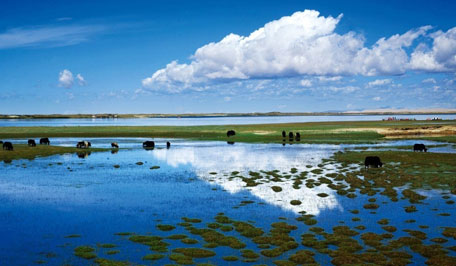The promising land with 'greenest' blueprint

 0 Comment(s)
0 Comment(s) Print
Print E-mail CNTV, April 18, 2016
E-mail CNTV, April 18, 2016
Ecological preservation has been pushed to the forefront of Chinese development as the country transitions to a ever greener development model. And in the latest move, plans to upgrade China's Sanjiangyuan Nature Reserve, located in the country's western Qinghai province, to a national park has entered the implementation phase.
 |
|
The promising land with 'greenest' blueprint |
It is the source of the Yellow and the Yangtze River. It is home to wild endangered species such as Tibetan antelopes and snow leopards. China's Sanjiangyuan (literally the sources of three rivers) is still in pristine condition despite environmental degradation elsewhere. And the central and local government intend to keep it that way as the process of making it a national park begins.
"Wetlands, water and fish, all these things make up a complete ecosystem. In order to protect the environment and ecosystem, we need to focus on the systematic and comprehensive management. Just suppose, if everyone wants to be in charge of it, nobody can really take the full responsibility," said Yang Rukun, director of Environment Protection Department in Qinghai Province.
According to the plan, the Sanjiangyuan National Park will cover its three most important elements: the Yangtze, Yellow and Lancang-Mekong River.
But also part and parcel to the plan are 12 towns, 53 villages, and the some 65,000 herdsmen who have been living off the land for generations.
For local authorities, there is the challenge of keeping a very delicate but crucial balance between development and ecological preservation.
"There is a large number and a wide spread of equus kiangs. We need to consider many factors. For example, the different species and population, their habitats, coexistence between human and animals and some factors threatening them," said Zhang Tongzuo with Northwest Plateau Biology Institute.
And here is yet another challenge: Different from other national parks worldwide, Sanjiangyuan is also where tens of thousands of herdsmen call home.
A survey conducted by the local government found that there are also 24,000 low-income households in the area.
"Here, we don't have coal, neither the revenue from cordyceps sinensis," said Droma Tsering, villager from Ye Magou Village of Ma Duo Town in Qinaghai.
"In terms of ecological supervision, including changes to the grass and water, we need to train these herdsmen into testers. There should be a mechanism of reward and punishment," Yang said.
There is consensus among local residents and governments that the preservation of Sangjiangyuan is a big job and that's why they are seeking all the help they can in the process of building the national park.
Local authorities say they welcome the input and expertise from not-for-profit organizations interested in lending a hand.
"Apart from a policy viewpoint, we also hope to solve some practical problems through some activities. For example, in Sanjiangyuan, we can minimize the conflicts between livestock husbandry development and the area's overall protection," said Fan Zhiyong, senior director of World Natural Foundation.
"The ecological environment has irreplaceable value. We should treat it as our lifeline and protect it like the apple of our eye." This is what President Xi said while joining a panel discussion with lawmakers from Qinghai province during the Two Sessions. With all of these efforts, under the greenest blueprint, the future of Sanjiangyuan National Park is promising. After all, protecting the fragile ecology there is of utmost importance.






Go to Forum >>0 Comment(s)